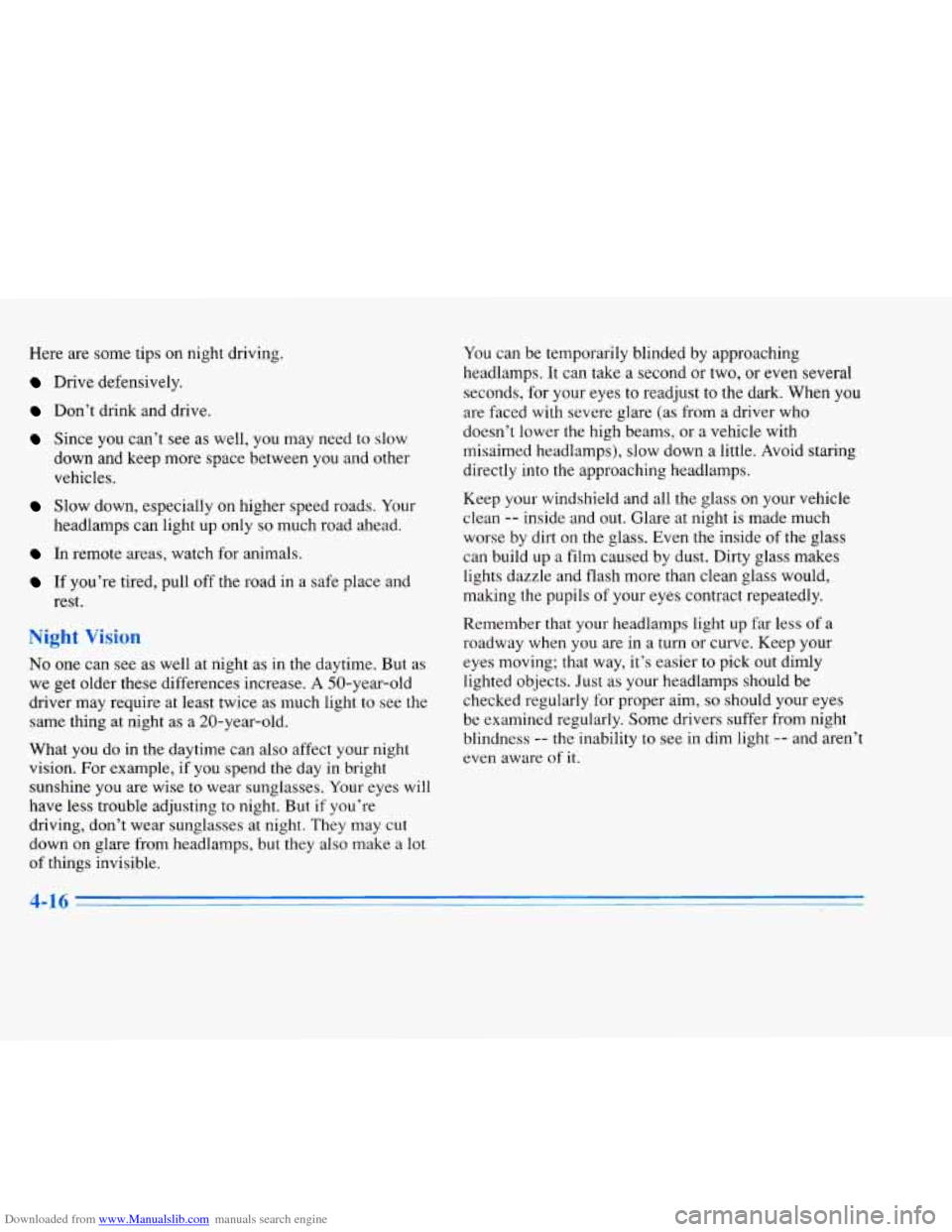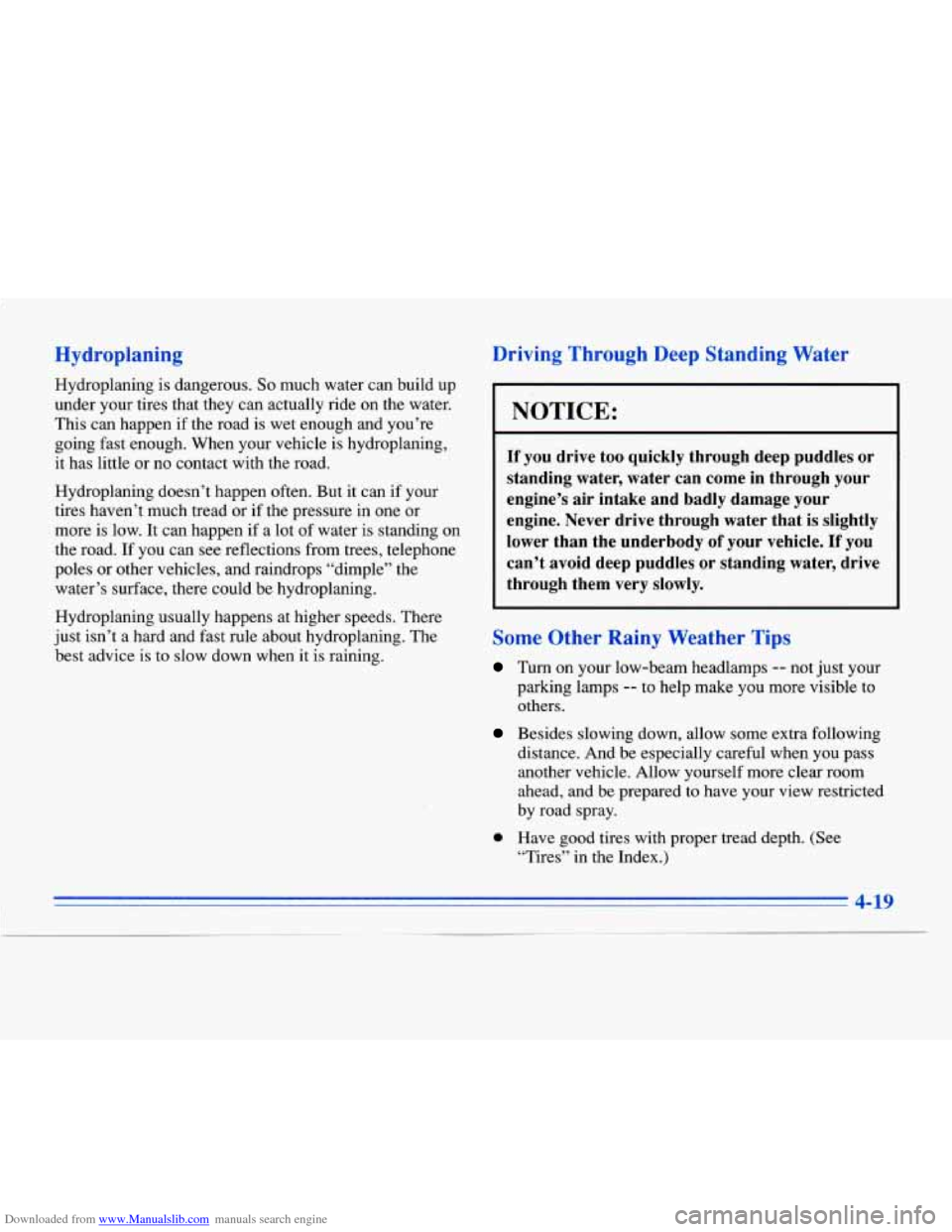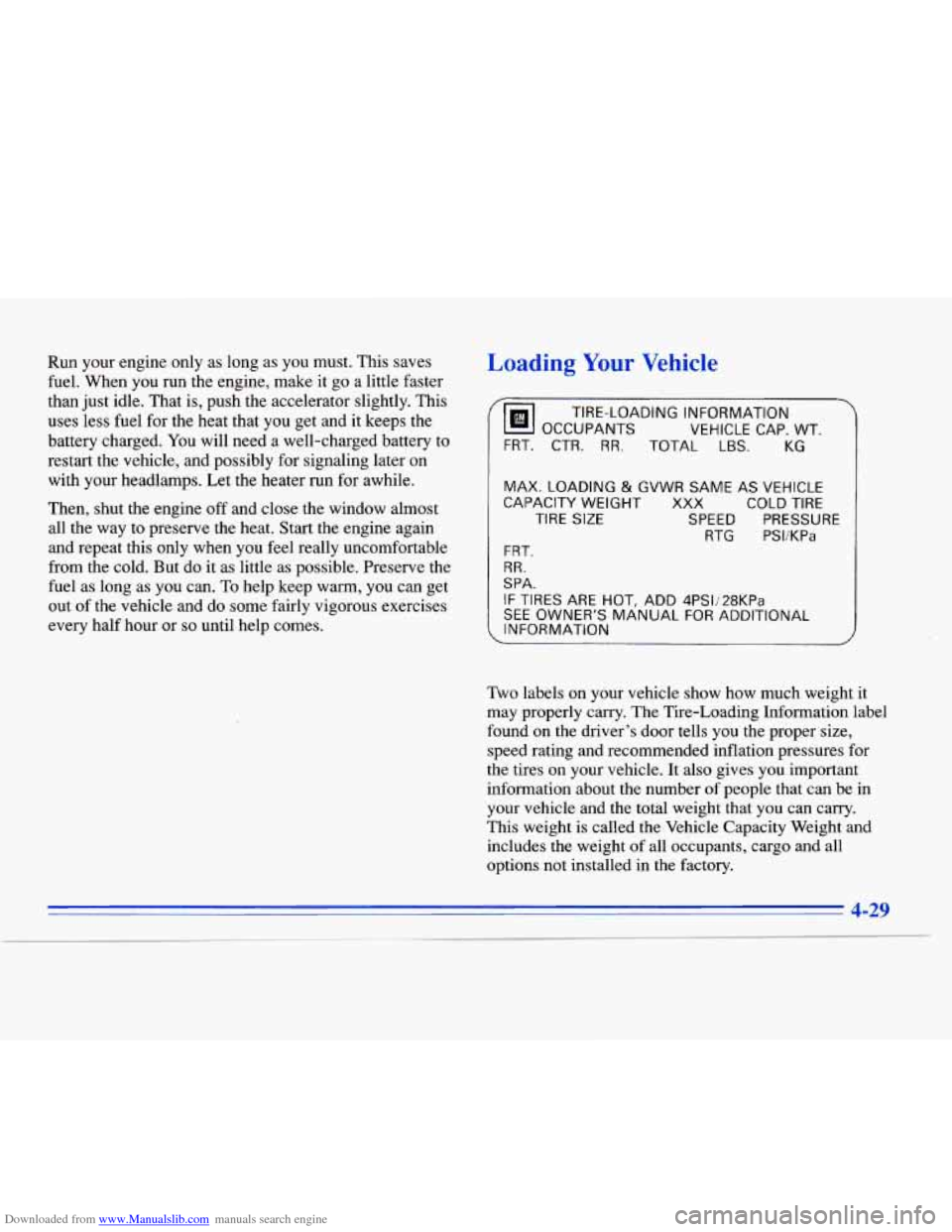Page 106 of 354
Downloaded from www.Manualslib.com manuals search engine Mirrors
Electrochromic Day/Night Rearview Mirror
Your Cadillac has an electrochromic dayhight
rearview mirror.
This mirror automatically changes to reduce glare from
headlamps behind you. A photocell on the'back
of the
'mirror senses when it is becoming dark outside. Another
photocell built into the mirror surface senses when
,
headlamps are behind you.
At night, when the glare is too high, the mirror will
gradually darken to reduce glare (this change may take a
few seconds). The mirror will return to its clear daytime
state when the glare is reduced.
On/Off Switch
Press the button at the base of the mirror to turn on the
automatic feature. The button has an indicator light to
show it is on. Press the button to turn the automatic
feature
off.
2-45
Page 107 of 354
Downloaded from www.Manualslib.com manuals search engine Time Delay
This feature prevents rapid changing of the mirror from
the night mode to the day mode as you drive under
lights and through traffic.
Reverse Gear Day Mode.
The reverse mode is another important feature of the
automatic mirror. When the
shift lever is placed in
' REVERSE (R), the mirror changes to the day mode.
This gives you a bright image in the mirror as you
back up.
Cleaning Photocells
Electrochromic Day/Night Rearview Mirror
with Compass (Option)
Use a cotton swab and glass cleaner to clean the front
and rear photocells that make the auto-dimming
feature work.
This mirror automatically changes to reduce glare when
set
in the M (Mirror) or C/M (Compass/Mirror) positions.
One photocell on the back
of the mirror senses when it is
becoming
dark outside. Another photocell is built into the
mirror surface to sense headlamps behind
you.
2-46
Page 111 of 354

Downloaded from www.Manualslib.com manuals search engine Driver’s Outside Auto-Dimming Rearview
Mirror (Option)
The driver’s side outside mirror will adjust for the glare
of headlamps behind you. This feature is controlled by
the on and off settings on the electrochromic mirror. See
“Electrochromic Daymight Rearview Mirror“ earlier
in
this section.
Convex Outside Mirror
Your passenger’s side mirror is convex. A convex mirror’s
surface
is curved so you can see more from the driver’s
seat. This mirror does not have
a dimming feature.
A convex mirror can make things (like other
vehicles) look farther away than they really are.
If you cut too sharply into the right lane, you
1 could hit a vehicle on your right. Check your
inside mirror or glance over your shoulder before
changing lanes.
Storage Compartments
Glove Box
The glove box is located in front of the passenger seat.
To lock the glove box door, insert the oval key in the
lock cylinder and turn
it clockwise. Turn the key
counterclockwise to unlock the door.
Map Focket
The driver’s door may have a map/storage compartment.
You may also have a storage compartment on the
passenger’s door.
2-50
Page 199 of 354

Downloaded from www.Manualslib.com manuals search engine Here are some tips on night driving.
Drive defensively.
Don’t drink and drive.
Since you can’t see as well, you may need to slow
down and keep more space between you and other
vehicles.
Slow down, especially on higher speed roads. Your
headlamps can light
up only so much road ahead.
In remote areas, watch for animals.
If you’re tired, pull off the road in a safe place and
rest.
Night ’
No one can see as well at night as in the daytime. But as
we get older these differences increase.
A 50-year-old
driver may require at least twice as much light to see the
same thing at night as a 20-year-old.
What
you do in the daytime can also affect your night
vision. For example,
if you spend the day in bright
sunshine you are wise to wear sunglasses. Your eyes
will
have less trouble adjusting to night. But if you’re
driving, don’t wear sunglasses at night. They may cut
down
on glare from headlamps, but they also make a lot
of things invisible. You
can be temporarily blinded by approaching
headlamps. It can take a second or two,
or even several
seconds, for your eyes to readjust to the dark. When
you
are faced with severe glare (as from a driver who
doesn’t lower the high beams, or a vehicle with
misaimed headlamps),
slow down a little. Avoid staring
directly into the approaching headlamps.
Keep your windshield and all the glass
on your vehicle
clean
-- inside and out. Glare at night is made much
worse by dirt on the glass. Even the inside of the glass
can build up a film caused by dust. Dirty glass makes
lights dazzle and flash more than clean glass would,
making the pupils
of your eyes contract repeatedly.
Remember
that your headlamps light up far less of a
roadway when you are in a turn or curve. Keep your
eyes moving; that way, it’s easier
to pick out dimly
lighted objects. Just as your headlamps should be
checked regularly for proper aim,
so should your eyes
be examined regularly. Some drivers suffer from night
blindness
-- the inability to see in dim light -- and aren’t
even aware of it.
4-16 -
Page 202 of 354

Downloaded from www.Manualslib.com manuals search engine Hydroplaning
Hydroplaning is dangerous. So much water can build up
under your tires that they can actually ride on the water.
This can happen if the road is wet enough and you’re
going fast enough. When your vehicle is hydroplaning,
it has little or no contact with the road.
Hydroplaning doesn’t happen often. But it can
if your
tires haven’t much tread or if the pressure in one or
more
is low. It can happen if a lot of water is standing on
the road. If you can see reflections from trees, telephone
poles or other vehicles, and raindrops “dimple” the
water’s surface, there could be hydroplaning.
Hydroplaning usually happens at higher speeds. There
just isn’t a hard and fast rule about hydroplaning. The
best advice is to slow down when it is raining.
Driving Through Deep Standing Water
NOTICE:
If you drive too quickly through deep puddles or
standing water, water can come in through your
engine’s air intake and badly damage your
engine. Never drive through water that
is slightly
lower than the underbody
of your vehicle. If you
can’t avoid deep puddles or standing water, drive
through them very slowly.
~~ ~
Some Other Rainy Weather Tips
Turn on your low-beam headlamps -- not just your
parking lamps
-- to help make you more visible to
others.
Besides slowing down, allow some extra following
distance. And be especially careful when you pass
another vehicle. Allow yourself more clear room
ahead, and be prepared to have your view restricted
by road spray.
0 Have good tires with proper tread depth. (See
“Tires” in the Index.)
4-19
Page 212 of 354

Downloaded from www.Manualslib.com manuals search engine Run your engine only as long as you must. This saves
fuel. When you run the engine, make it go a little faster
than just idle. That
is, push the accelerator slightly. This
uses less fuel for the heat that you get and it keeps the
battery charged. You will need a well-charged battery to
restart the vehicle, and possibly for signaling later on
with your headlamps. Let the heater run for awhile.
Then, shut the engine off and close the window almost
all the way to preserve the heat. Start the engine again
and repeat this only when you feel really uncomfortable
from the cold. But do it as little as possible. Preserve the
fuel as long
as you can. To help keep warm, you can get
out of the vehicle and do some fairly vigorous exercises
every half hour or
so until help comes.
Loading Your Vehicle
‘ OCCUPANTS
VEHICLE CAP. WT.
TIRE-LOADING INFORMATION
FRT. CTR.
RR. TOTAL LBS. KG
MAX. LOADING & GVWR SAME AS VEHICLE
CAPACITY WEIGHT
XXX COLD TIRE
TIRE SIZE SPEED PRESSURE
RTG PSI/KPa
FRT.
RR.
SPA.
IF TIRES ARE HOT. ADD 4PS1/28KPa
SEE OWNER’S MANUAL FOR ADDITIONAL
INFORMATION
Two labels on your vehicle show how much weight it
may properly carry. The Tire-Loading Information label
found on the driver’s door tells you the proper size,
speed rating and recommended inflation pressures for
the tires on your vehicle. It also gives you important
information about the number of people that can be in
your vehicle and the total weight that you can carry.
This weight is called the Vehicle Capacity Weight and
includes the weight of all occupants, cargo and all
options not installed in the factory.
I
4-29
Page 288 of 354
Downloaded from www.Manualslib.com manuals search engine Bulb Replacement
For any bulb changing procedure not listed in this
section, contact your Cadillac dealer service department.
Halogen Bulbs
Headlamps
A CAUTION:
Halogen bulbs have pressurized gas inside and
can burst if you drop
or scratch the bulb. You or
others could be injured. Be sure to read and
follow the instructions on the bulb package.
1. Remove the cover by turning the lock tabs in the
direction
of the arrows as shown on the cover.
6-29
Page 289 of 354
Downloaded from www.Manualslib.com manuals search engine 2. Turn the headlamp housing socket counterclockwise
to unlock the socket from the lamp housing.
I
3. Remove the headlamp housing socket.
6-30 .